
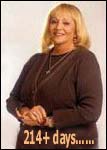 Recently, on MSN, Sylvia Browne (now into 214+ days on her "clock" which you will see on our opening page) lied to her audience by saying that I'd made no attempt to contact her regarding her promise to be tested by the JREF. Can't blame her, I suppose, because she's well aware that she could never pass a simple, proper, test of her claims, in fulfillment of her promise. But I must keep the record straight, thus this item. Reader Scott Kinkade notes:
Recently, on MSN, Sylvia Browne (now into 214+ days on her "clock" which you will see on our opening page) lied to her audience by saying that I'd made no attempt to contact her regarding her promise to be tested by the JREF. Can't blame her, I suppose, because she's well aware that she could never pass a simple, proper, test of her claims, in fulfillment of her promise. But I must keep the record straight, thus this item. Reader Scott Kinkade notes:
I'm sure you noticed the particular language that Sylvia Browne used in response to the question on MSN about your standing challenge. She spoke about your challenge and your "failure to contact her" as if they were events in the distant past. Rather than saying "He hasn't contacted me," she chose the more final statement, "I waited and he never contacted me."Rest assured that henceforth Sylvia will tell herself, and anyone else who will listen, that your challenge and her acceptance were events come and gone without fruition, like a failed corporate merger that was proposed then abandoned. If asked again she will likely respond "Oh that? No, that never went through." Over time she will shade it to sound as if you withdrew the challenge. All her fans/followers will believe her, and your associates will, as always, be able to see the truth.
Quite so, Scott. So that any doubt on the matter will be resolved, here is a copy of the letter that I've sent — more than once, the last time just last week — to Ms. Browne:
Sylvia Browne, Sylvia Browne Corporation
Society of Novus Spiritus
35 Dillon Avenue
Campbell, CA 95008
March 26, 2002
(This is a copy of the letter originally sent to you on March 18th, 2001.)
Ms. Browne, you have accepted, on nationwide TV via the Larry King Live show, on March 6th of 2001, to be tested by this Foundation for the million-dollar prize that we offer, as described on our web page, www.randi.org.
We stand ready to discuss with you or your representatives, the parameters of such a test, whether it be of your claim that you are in contact with dead persons, or that you can predict the future, or any other paranormal, occult, or supernatural ability. Tests can be designed that would show clearly whether or not these claims are valid.
We have offers from several major, well-qualified, university faculties here in the USA who have offered to help design and implement any testing procedure. Be assured that no one from the James Randi Educational Foundation would be involved in any way that might affect the outcome or implementation of any test.
We await with interest your response to this statement, and to your acceptance as previously announced. The addresses, phone and fax numbers, and Internet/e-mail contacts for the Foundation are listed here for your convenience.
Thank you for your attention to this inquiry.
Signed,Certified Mail, March 26/02
James Randi
And to thoroughly firm up the matter, here are the latest Certified Mail documents we have on file:
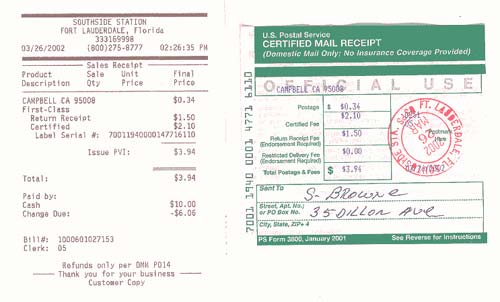
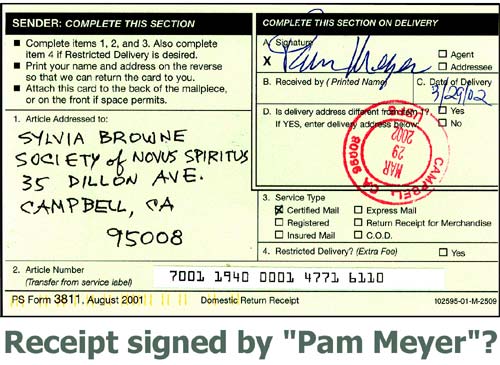
(The more observant reader will perhaps be struck by the fact that 395+ days have passed since the date (March 6, 2001) that Sylvia first agreed to take the JREF test, and not the 214+ listed on Ms. Browne's clock. This is explained by the fact that her acceptance on March 6, 2001- which was also made live, on internationally-viewed TV — was made before I'd had a chance to formulate the exact rules for a test, which would have to be done before Ms. Browne would know whether she'd like to take the test. We have since communicated that protocol to her — on September 3, 2001 — and the clock was started on that date.)
Apparently Sylvia doesn't care for the test design, though we don't know because she will not respond to inquiries....
Reader Peter Himmelreich, a registered Emergency Medical Technician, offers us this insight into the practice of "snake handling" and "drinking of poison" that some, particularly in the region of the southern Appalachian mountains, practice even today in their religious services. The movement had its origin in about 1910, and is based on First Corinthians, verses 13:8-10. But Peter has a more informed view than most of us about this "supernatural" carrying-on:
I find your web site very informative and offering some critical thinking and scientific methodology, which our society is in much need of in regard to "paranormal" claims. For entertainment, I recently watched a TV show "Beyond Bizarre" wherein they showed fundamentalist Christians dancing with rattlesnakes and drinking rat poison. According to the show there were individuals who had been bitten over a hundred times, and a laboratory test showed that the liquid was indeed rat poison.The implication seemed to be that
1) This is unexplainable by scientific means, that adults could drink rat poison and be bitten by rattlesnakes, and survive, and2) that since this occurred, there must be an appeal to the paranormal (or miraculous) for an explanation.
This claim was comical to me (although it is sad to see sincere people deceived) even with the little background knowledge I have. From my training to become an Emergency Medical Technician, I learned that contrary to "common sense" (which is sometimes nonsense), rattlesnake bites are NOT commonly fatal in adults without the additional presence of severe underlying medical problems.
Additionally, I learned that ideas about which substances are actually more poisonous, are in fact often counter-intuitive. As an example, my instructor noted that an adult could survive ingesting a whole container of rat poison, whereas a capful of certain furniture-polish mixtures could kill several adults, or an interaction of certain over-the-counter medicines with alcohol could be lethal. Thus, that adults survive rattlesnake bites and drinking rat poison is NOT miraculous but a well-known medical fact! Therefore, there is nothing "bizarre" about it!
I'll add this observation to Peter's: years ago in Canada, a male relative in my family who was trained in pharmacology dared to taste a drop of the "rat poison" (strychnine is the most commonly used) that he found in a bottle used at a religious meeting by the fanatics who revel in doing such weird things. He reported that it was extremely bitter, and the brave man found that when he later made exceedingly dilute solutions of the substance, almost any concentration — even very, very, dilute — provided the same degree of bitter taste. Looking up the dosage considered sufficient to cause serious effects on a human being, and knowing the concentrations he was preparing for his tests, he concluded that there was certainly not enough substance present in those solutions that the zealots were drinking. In fact, if I recall correctly, he told me that they would have had to consume several liters of the "cocktail" to even begin to notice any real effect. And, customarily, the dancers take a quick sip and declare a miracle.
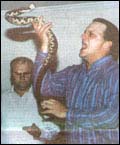 Also, we regularly hear of these folks being bitten by the rattlesnakes they handle, and dying as a result. As an example, here is John Wayne "Punkin" Brown, Jr., Pentecostal church preacher, 34, just before he was fatally bitten on a finger in 1998. So where's the miracle?
Also, we regularly hear of these folks being bitten by the rattlesnakes they handle, and dying as a result. As an example, here is John Wayne "Punkin" Brown, Jr., Pentecostal church preacher, 34, just before he was fatally bitten on a finger in 1998. So where's the miracle?
You will recall that we at the JREF now own a real (gulp!) E-meter. Author Paulette Cooper, in her book, "The Scandal of Scientology,"(1970) discusses the Scientology "E-meter,"and she has granted permission for me to share this excerpt with my readers, but I recommend that if you have any further interest in this subject, you should obtain the book, published by Tower Books. A Web version is also available.

L. Ron Hubbard himself stated that, "The E-meter is never wrong. It sees all; it knows all. It tells everything."An important part of a Scientology "auditing" session is the E-meter. It lures people into Scientology and, for some, gives a scientific basis to the methods used. Scientologists are accepted or expelled according to its revelations. It helps to extract the Scientologists' most intimate secrets and confessions, including those of a sexual and criminal nature. It helps to determine the length, intensity and nature of the auditing session. It helps to determine the date and details of their present problems and their past lives.
In fact, the E-meter often determines whether they have had past lives. If someone believes he hasn't lived before, but the E-meter does not respond to a date in the person's current life, then he is led to believe that the event must have happened in a past one.
The E-meter or electroencephaloneuromentimograph is about ten inches by six inches by two inches and its appearance was described by one reporter as a "cross between a car speedometer and a practical joker's electric shock machine." Hubbard usually refers to its inventor as "Mathison" and Scientologists will tell you it was invented by Olin Mathison; actually it was invented by Volney Mathison, a chiropractor.
To buy the machine at an Org [Scientology office/outlet] costs [1970] about $162; in 1963 the government determined that it cost only $12.50 to make, and that the Scientology organizations bought it wholesale for $47.
Randi adds: the latest model of the device — the "Mark Super VII Quantum" — goes for a whopping $4,650, but we must consider that this one has "new electrodes and cleaning wipes." Of course, the faithful don't pay that price for it, but donate that amount of money to receive it. It's a church, don'tcha know, and like all churches, we pay to support their mythology, and we pay their taxes. Why do I get the feeling — again — that I'm in the wrong business....? The "Source" magazine published by the Church of Scientology has a page headed, "Donation rates," which in any other business would be called "Merchandise prices." You can buy — excuse me, receive for a donation! — audio cassettes in Danish, Dutch, English, French, German, Greek, Hebrew, Hungarian, Italian, Japanese, Norwegian, Portugese, Russian, Spanish, and Swedish, and take instruction for the exalted condition known as "OT VI" (that's "Operating Thetan, Sixth Class"!) for only $17,000 — accommodation and meals not included. Back to Paulette's comments:
Even at this price [$162], the Scientologists and Hubbard will tell you that it's infallible. It is said that it never fails to pick out the date on which an incident occurred. Scientologists will tell you to the exact second when something happened to them trillions of years ago.Apparently, it is less than perfect in picking dates in their current life. Its failure in this task is what caused author Alan Levy, who wrote a piece on Scientology for Life Magazine, to become disenchanted with the organization. (Along with the fact that his New York contract said Grades V-VII [of the Scientology course] would cost him $390 at Saint Hill, but when he got there he discovered it was $3,150 "plus living expenses.") Levy's problems in Scientology started when he was told to use the E-meter to locate the date on which he had a fight with his wife. (Present one, current life.) Without the meter, he knew the year was 1958, and that it was a Sunday morning in March.
Although he suggested to his auditor that they consult a calendar, he was told, "There's no need for that. . . . The E-meter will find out for us." The meter "found out" that the fight occurred on March 18. But when Alan Levy checked an almanac at a bookstore in East Grinstead, he discovered that March 18, 1958 fell on Tuesday, not Sunday. He wrote:
It seems pathetic to me still, and terribly precarious, that my failure to perform so simple a journalistic chore — under other circumstances I would have automatically looked up the date — could have kept me half tied to Scientology, the deep-probing auditing sessions and the damned E-meter. . . . I am sure that among the millions of words . . . [Hubbard] has written, there are some to convince me that the engram I unlocked did happen on a Tuesday — in another life — or that March 18 did fall on a Sunday when I was in the womb. But thankfully it no longer matters.A number of government witnesses in the Food and Drug Administration's case against the E-meter also agreed that its functioning was considerably less than perfect. George Montgomery, Chief of the Measurement Engineering Division of the National Bureau of Standards, and Dr. John I. Lacey, Chairman of the Department of Psychophysiology and Neurophysiology at Fels Research Institute in Yellow Springs, stated that the E-meter "failed to meet the commonly accepted criterion by which such an instrument is judged."
This was because:
1. The E-meter has no device to control the constancy of current.2. Holding a can in the hand permits great variations in the area of the skin in contact with the metal electrodes, and would allow great variation in the amount of actively sweaty tissue that is in contact with it.
3. The instrument is subject to polarization.
4. It is not a quantitative instrument due to uncontrollable variations in skin contact and current.
These experts also explained that the machine was not really a measure of skin resistance at all, but partially a reading of how firmly the individual was grasping the can; if the person squeezed the can, there was more contact, and apparent skin resistance would drop. If he held the cans loosely, the apparent skin resistance would simply increase. Scientologists, on the other hand, claim that the E-meter is so sensitive that it will react not only when a person is holding onto it, but also when it is placed on a tomato — garden variety, that is. While some people would view this as an argument against the meter, Scientologists feel that this proves its validity and that it also supports their hypothesis that plants have feelings like humans.
Scientologists have admirably gone to the trouble to research a number of experiments in this field and have presented them to the public in their newspapers and press releases. These experiments were as follows:
1. Dr. Erwin Kapphan, in Zurich, "using a sensitive version of the skin galvanometer" ("similar to the E-meter used in Scientology confessionals," said the press release) showed that a tomato, when pierced with a nail, showed "definite emotional anxiety reactions" similar to those of humans. Kapphan also said that "plants only catch a disease or blight if they are already thinking of dying."2. Dr. Bernard Grad, at McGill University in Montreal, conducted experiments which showed that plants fertilized by a solution that had been given a flow of attention by a well-known faith healer with acknowledged extrasensory powers grew significantly faster and bigger than other plants.
3. Dr. Rex Stanford, of Duke University, showed that plants which are shown love, affection and lots of warm attention grow "demonstrably faster and bigger."
The press release contained no information about the statistical levels of significance of these experiments, or even how the experiments were carried out (for example, how did they give "love" or a "flow of attention" to a plant?) nor how the results were analyzed (how does a tomato show "definite emotional anxiety reactions"? etc.) They simply stated, in a rather unscientific but sincere manner, that three experiments proved beyond doubt that Hubbard's theory (and by extension, the E-meter) was valid. "After ten years of ridicule for his theory . . . L. Ron Hubbard has finally been vindicated . . . totally validated . . . it was about time."
The reader may decide for himself whether the E-meter proves that plants feel pain, have emotional anxiety reactions, grow faster when given a flow of attention by a faith healer, etc., — or whether to accept the word of the chairman of the Department of Psychophysiology and Neurophysiology at one institute and the Chief of the Medical Engineering Division, that the E-meter is not an accurate instrument for measuring the flow of electricity.
But if you choose the latter, just remember that you cannot argue your position with the Scientologists. They claim that the E-meter registers the thetan [a mythical superhuman that can be created by proper Scientology instruction], which they believe may have an electrical voltage, and since no non-Scientologist has ever seen a thetan, much less checked it for electricity, how can anyone possibly disprove this theory?
Yes, the whole Scientology matter sounds like a bad script for a bad movie, but it's hogwash accepted by thousands of the gullible. To appreciate even more fully the zany philosophy that calls itself Scientology, go to www.xenu.net, and properly equipped with anti-nausea medication, read. This is the site that the Church of Scientology tried to get taken out of the Google.com listings! And for an excellent collection of articles on and about Scientology, visit www.freedomofmind.com/groups/scientology/scientology.asp
I'm off to slice up some tomatoes for lunch, callously ignoring in my insensitive way, their piteous screams for mercy....
 We've just been notified that good friend Michael Shermer's fine book, "Why People Believe Weird Things," has now also been published in China, in Chinese. It appears that skepticism and critical thinking are becoming very popular in the Middle Kingdom!
We've just been notified that good friend Michael Shermer's fine book, "Why People Believe Weird Things," has now also been published in China, in Chinese. It appears that skepticism and critical thinking are becoming very popular in the Middle Kingdom!
Michael Gilmore of Torrance, California, is a twenty-year veteran of the space program and a Fellow of the British Interplanetary Society. He writes often for Skeptic Magazine, which I trust all my readers also subscribe to. He has generously granted us permission to use this article, written last February....
The Fossil and the Meteor
February 12 is Charles Darwin's birthday, and February 19 is that of Nicholas Copernicus. We are a scientific civilization, and there is much to celebrate.
On my desk sit two little stones, one a trilobite fossil, about half-a-billion years old, the other an iron meteorite, of unknown age. They represent the two greatest turning points in science: the Darwinian and the Copernican revolutions.
It was not the purpose of Copernicus to explain meteors when he argued for a sun-centered astronomical system in 1543, but he started a long scientific argument, lasting more than three centuries, that eventually explained the nature and origin of meteorites. We have discovered some wonderful things along the path that Copernicus started, including the incredible fact that rocks can fall from the sky.
Seventy years after Copernicus, his cosmological revolution was enlarged by Galileo (a February 15 birthday!) and introduced to scholars and the public alike. It is our immense good fortune that this revolution, which shows how both Earth and the heavens follow the same natural laws, continued to grow. Pockets of resistance existed, however. When a statue of Copernicus was erected in Warsaw in 1839, no priest could be found to officiate. Copernicus' book had only been removed from the Catholic Church Index of banned books [Index Librorum Probibitorum, begun in 1559, last published in 1948, and abandoned in 1966], in 1835.
In that very same year a young English naturalist was on the other side of the planet exploring the Galapagos Islands. He was making observations that would eventually be part of his most famous book, published nearly a quarter of a century later, The Origin of Species. Darwin's revolution would be like Galileo's, a popular affair followed closely by both scholars and the public.
Nearly a century-and-a-half later the public debate continues, although that is now mostly an American phenomenon. A first-rate popular science series, Evolution, was broadcast last fall, at prime time, on PBS. Later-day creationists were complaining even before the series started. A revolution that was settled, scientifically, over a century ago, is still a hot button issue in the United States.
Mankind has suffered numerous displacements from what we thought was our proper and rightful place at the center of the universe and at the pinnacle of creation. However, it is the Darwinian scientific revolution that disturbed us the most, although the Copernican revolution comes in as a close second. We now know we live on a small Darwinian branch, on a pale blue dot of a planet, somewhere out in the cosmic boondocks.
Drawing from within the scientific revolution, I suggest a cure for our bruised ego. As a thought experiment, try turning things on their heads. Begin by viewing these revolutions not as demotions but as inclusions. See yourself as a part of the natural world and thus as part of the unfolding of a remarkable and mysterious universe. Consider yourself, as Carl Sagan suggested, "star stuff" contemplating "star stuff." The more you understand about our origins, our evolution, and our place in the universe, the more you can feel yourself a part of this inclusion. At some point you might even feel more at home. In fact, it could make you feel downright spiritual. As the American psychologist William James suggested, you may find a true religious sense "when you have a feeling of being at home in the universe."
Science is a very human enterprise that always stands on the edge of error. Scientific knowledge is never absolute. Even so, evolution is as certain as the existence of atoms, or the revolution of our planet about the Sun. We have added a lot to science, and we will always quibble a bit, but both Darwin and Copernicus had it right.
The little fossil and meteorite on my desk hold for me a sense of wonder and adventure. As they whisper of the mysteries of deep-time and deep-space, they tell some wonderful stories, stories that I hope we will all come to know and cherish. They are the stories of science, stories that should make us all feel more at home in the universe. To learn more about Darwin's revolution go to: www.pbs.org/wgbh/evolution. A Congregational Study Guide for Evolution, for your place of worship, is at: www.ncseweb.org.
Heartily endorsed and happily presented to our readers, Michael. Many thanks!
 On April 1st of each year, the JREF proclaims the yearned-for Pigasus "Flying Pig"awards in four categories, for accomplishments in the year previous. We allow the Academy Awards to occur before ours, so that we don't distract from their festivities. The awards are of course announced to the winners via telepathy, the winners are allowed to predict their triumph in advance, and the Flying Pig trophies are sent to the winners via psychokinesis. We send; if they don't receive, that's probably due to their lack of paranormal talent. In case you missed the announcement, here are the official winners:
On April 1st of each year, the JREF proclaims the yearned-for Pigasus "Flying Pig"awards in four categories, for accomplishments in the year previous. We allow the Academy Awards to occur before ours, so that we don't distract from their festivities. The awards are of course announced to the winners via telepathy, the winners are allowed to predict their triumph in advance, and the Flying Pig trophies are sent to the winners via psychokinesis. We send; if they don't receive, that's probably due to their lack of paranormal talent. In case you missed the announcement, here are the official winners:
This year, 2002, the Pigasus prizes for achievements of last year, 2001, go to:Category #1, for the scientist who said or did the silliest thing related to the supernatural, paranormal or occult, goes unavoidably to Dr. Gary E. Schwartz of the University of Arizona, for his "testing" of psychic mediums that he reported to the media as "90% accurate." Despite pleading by embarrassed friends and colleagues at the U of A, Dr. Schwartz has refused to back up these assertions by further examination of the subjects. His "findings" were widely reported by the international media, and Dr. Schwartz was careful in interviews to point out his credentials, as if that established the validity of his actual statements.
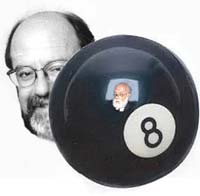
As a single example of his poor control of the "experiments" in "carefully isolating" a subject from a psychic during the tests — so that the psychic would have no information about the subject — he failed to notice the psychic clearly peeking into the adjoining area, but when it was pointed out to him, he shrugged it off as an unimportant factor. So much for scientific rigor.(The University of Arizona has turned down my offer to pay them the million-dollar prize if Dr. Schwartz would send us the confirming raw data on these tests — which he promised to do — but the University told us they were not interested. Incredible. Schwartz also sniffed, that as an academic, he would not try for any prize. That presumably includes the one offered by Nobel....)
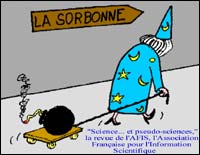
Category #2, for the organization that supported the most useless study of a supernatural, paranormal or occult claim, goes overseas this year to the French university, Paris-la Sorbonne, the seat of the faculty of Arts & Letters at the University of Paris. This prestigious center of learning awarded a doctorate in Sociology to �lizabeth Teissier after she delivered to them a 900-page thesis, a plea for the validity of astrology. Needless to say, this sort of scandal had never happened before in the 742-year history of the university. It is said that former graduates of the world-famous Sorbonne are still heard noisily spinning in their graves, tout malades qu'ils sont.Category #3, for the media outlet that reported as fact the most outrageous supernatural, paranormal or occult claim, we had to decide whether to split the honor among several media, but because of their determined emphasis on this particular item of nonsense, we decided it should go to the CNN TV Network, who devoted a whole day to promoting a news photo of the World Trade Towers collapsing on 9/11, a gruesome shot which was interpreted as a profile of Satan supernaturally created by the smoke. In this time of utter tragedy and sorrow, we were subjected to this juvenile fancy, and made to look to the rest of the world like juveniles.
Category #4, for the "psychic" performer who fooled the greatest number of people with the least talent, of course goes to John Edward, the man who plays "Twenty Questions" for higher stakes than anyone ever has — millions of dollars a year — via the "Crossing Over" TV show that is featured on major networks, here and abroad. Edward, far more often wrong than right in his guesses, uses the grieving, the bereaved, the vulnerable, as his subjects and victims, people who desperately look for evidence that their loved ones are still around somewhere. Though hardly the most talented performer of this variety of scam, Edward adopts an aggressive attitude and an unctuous smirk to lubricate his escape from his frequent blunders.
As you might expect, there were the usual number of attempted bribes from those who sought this coveted award, but we successfully resisted all. We're Untouchable in this regard. But if you feel you'd like to get the heady feeling of carrying off a Pigasus Award, we have our attractive Pigasus lapel/tie pins, in genuine pewter, for sale. Just $8.50 brings it to your door!
Next week, more fire and brimstone.....!
"Reality is that which, when you stop believing in it, doesn't go away."
- Philip K. Dick, science-fiction author
